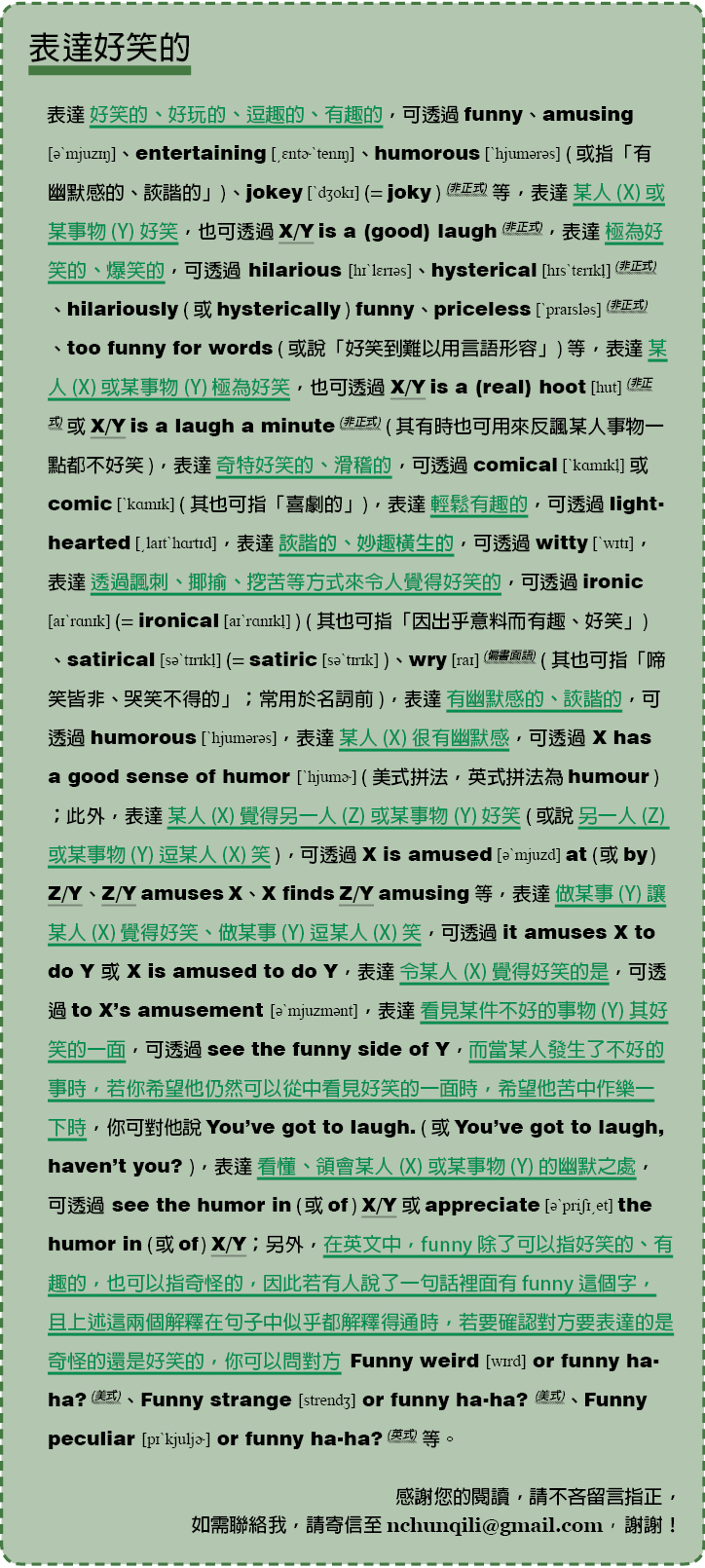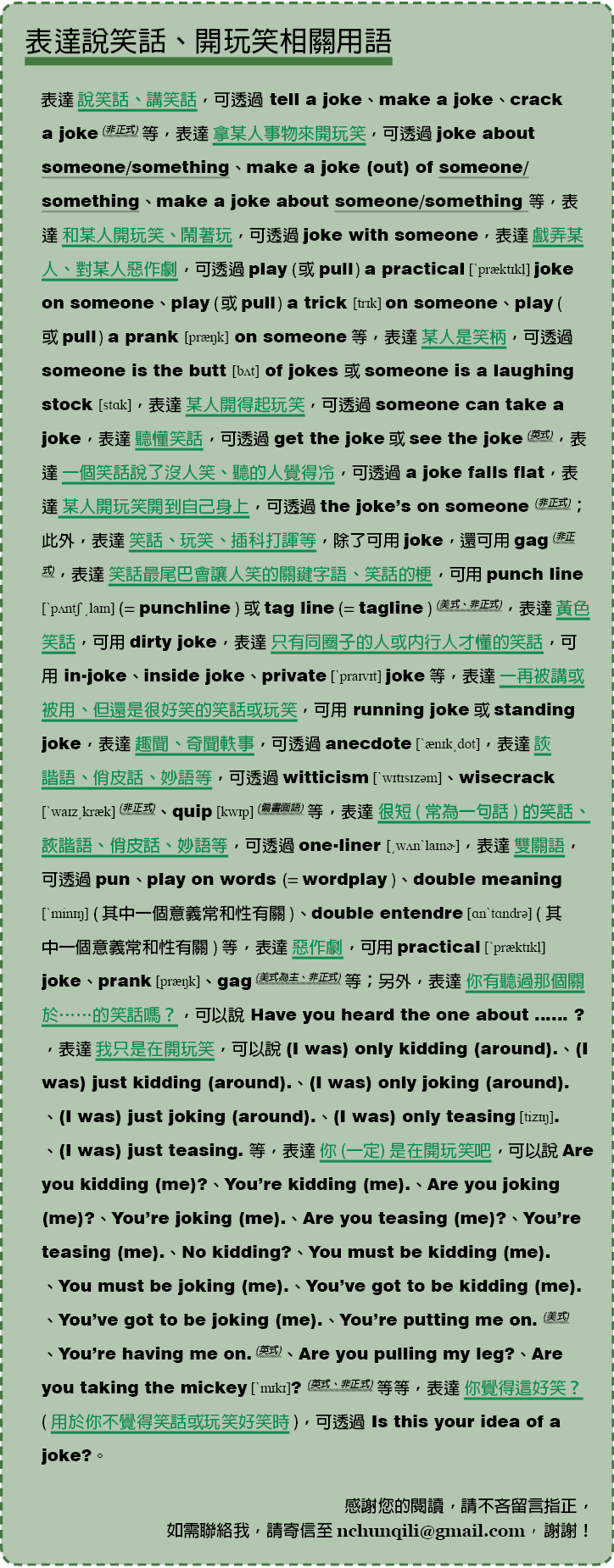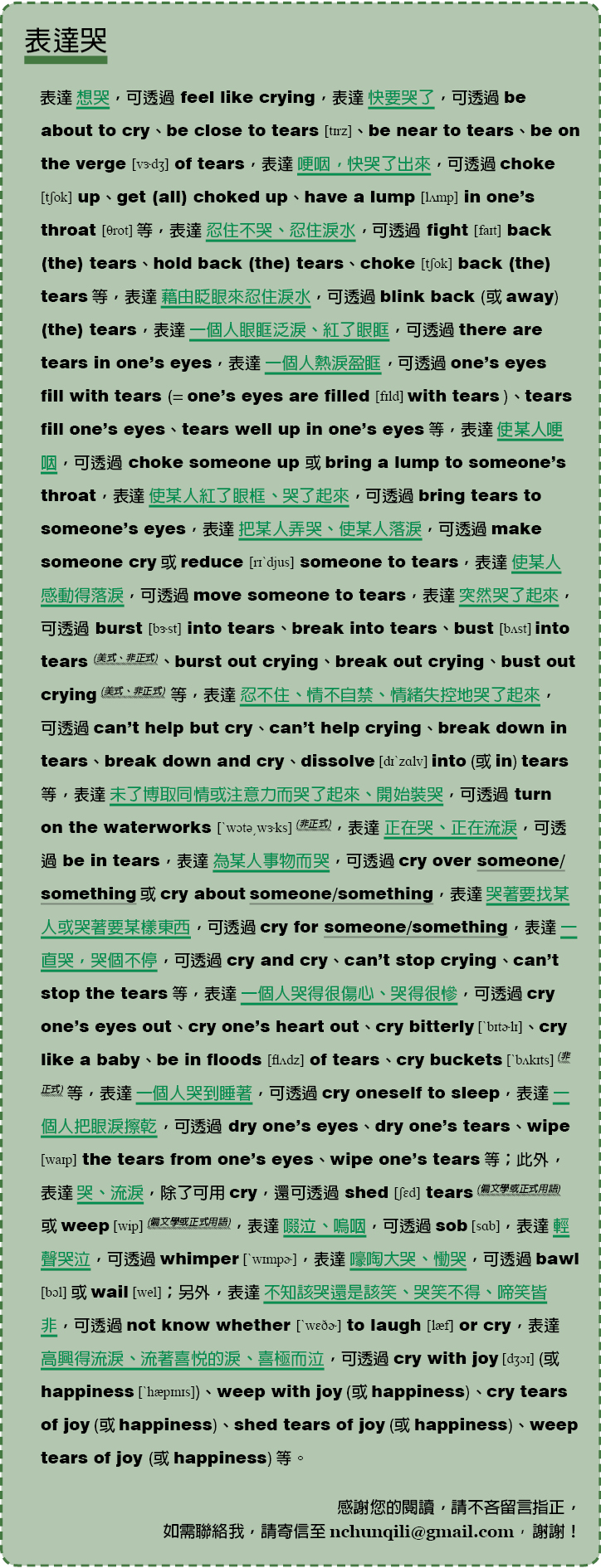表達 學齡前兒童 ( 約 2-5歲 ) 所念的托兒所、幼稚園,可用 nursery school、preschool (美式為主)、kindergarten ( 作此義解時為英式用法 ) 等,表達 在美國給 5 ( 或 6 ) 歲兒童念的學校,可用 kindergarten ( 作此義解時則為美式用法 ),表達 在英國給 4-7 ( 或 5-7 ) 歲小孩念的學校,可用 infant school (英式),表達 在美國給 5-11 歲的小孩念的學校,可用 elementary school (美式)、grade school (美式)、grammar school (美式、舊式) ( 另 grammar school 在英式英文中則是指需通過入學考試、給 11-18 歲的小孩所念的學校 ( 尤指在過去時 ) ) 等,表達 在英國給 5-11 歲小孩念的學校,可用 primary school (英式),表達 在英國給 7-11歲小孩念的學校,可用 junior school,表達 在美國給 11-14 ( 或 10-14 ) 歲的小孩、在英國給 9-13 ( 或 8-12 ) 歲的小孩念的學校,可用 middle school ( 其在美式用法中也可稱為 intermediate school (美式) ),表達 在美國給 14-18 歲、在英國給 11-18 ( 或 11-16 ) 歲小孩念的學校,可用 secondary school ( 其在英式用法中也可稱為 senior school (英式),此乃相對於 junior school (見上) 而言 ),表達 在英國給 14-18 歲小孩念的學校,可用 upper school (英式),表達 在美國給 12-14 ( 或 12-15 ) 歲小孩念的學校,可用 junior high (school) (美式) ( 其也可稱為 intermediate school (美式) ),表達 在美國給 14-18 ( 或 15-18 ) 歲小孩唸的學校,可用 senior high (school) (美式) 或 high school (美式) ( 另 high school 在英式英文中則是常被用於給 11-18 歲小孩唸的學校 ( 即 secondary school ) 的名稱中 ),表達 在英國接受各種資質學生、給 11-18 ( 或 11-16 ) 歲的小孩唸的公立學校,可用 comprehensive (school) (英式) 或 comp (英式、非正式),表達 在英國給 16-18 歲、要準備進階資格考試 ( 如大學入學資格考 — A level ) 的學生念的學校,可用 sixth form college [ˋsɪksθ fɔrm ͵kɑlɪdʒ] (英式),表達 「準備學校」( 其在美國是指給 14-18 歲、準備升大學的小孩念的私立學校,在英國則是指給 7-13 歲、準備升 public school (其英式用法的解說見下) 的小孩唸的私立學校 ),可用 preparatory school (= prep school (非正式) ),表達 藉由提供特殊課程以吸引其他學區的學生來就讀的學校,可用 magnet school (美式為主),此外,表達 公立學校,可用 public school (美式) 或 state school (英式) ( 但注意 public school 在英式用法中則是指給 13-18 歲小孩唸的私立 (寄宿) 學校 ),表達 私立學校,可用 private school、independent school (英式為主)、fee-paying school 等 ( 另外,在美國給 14-18 歲小孩唸的私立學校的名稱中有時會用到 academy [əˋkædəmɪ] 這個字,在英國給 11-18 歲小孩唸的學校 ( 尤其是私立學校 ) 的名稱中則有時會用到 college [ˋkɑlɪdʒ] 這個字 ),表達 寄宿學校,可用 boarding school 或 residential school (英式),表達 不提供寄宿的私立學校,可用 day school ( 其也可指「日校」) ................ ( 未完,續「表達各種學校 (下)」)
Jan 31, 2011
Jan 30, 2011
表達好笑的
表達 好笑的、好玩的、逗趣的、有趣的,可透過 funny、amusing [əˋmjuzɪŋ]、entertaining [͵ɛntɚˋtenɪŋ]、humorous [ˋhjumərəs] ( 或指「有幽默感的、詼諧的」)、jokey [ˋdʒokɪ] (= joky ) (非正式) 等,表達 某人 (X) 或某事物 (Y) 好笑,也可透過 X/Y is a (good) laugh (非正式),表達 極為好笑的、爆笑的,可透過 hilarious [hɪˋlɛrɪəs]、hysterical [hɪsˋtɛrɪkḷ] (非正式)、hilariously funny、hysterically funny、priceless [ˋpraɪsləs] (非正式)、too funny for words ( 或說「好笑到難以用言語形容」) 等,表達 某人 (X) 或某事物 (Y) 極為好笑,也可透過 X/Y is a hoot [hut] (非正式)、X/Y is a real hoot [hut] (非正式)、X/Y is a laugh a minute (非正式) ( 其有時也可用來反諷某人事物一點都不好笑 ) 等,表達 奇特好笑的、滑稽的,可透過 comical [ˋkɑmɪkḷ] 或 comic [ˋkɑmɪk] ( 其也可指「喜劇的」),表達 輕鬆有趣的,可透過 light-hearted [͵laɪtˋhɑrtɪd],表達 詼諧的、妙趣橫生的,可透過 witty [ˋwɪtɪ],表達 透過諷刺、揶揄、挖苦等方式來令人覺得好笑的,可透過 ironic [aɪˋrɑnɪk] (= ironical [aɪˋrɑnɪkḷ] ) ( 其也可指「因出乎意料而有趣、好笑」)、satirical [səˋtɪrɪkḷ] (= satiric [səˋtɪrɪk] )、wry [raɪ] (偏書面語) ( 其也可指「啼笑皆非、哭笑不得的」;常用於名詞前 ),表達 有幽默感的、詼諧的,可透過 humorous [ˋhjumərəs],表達 某人 (X) 很有幽默感,可透過 X has a good sense of humor [ˋhjumɚ] ( 美式拼法,英式拼法為 humour );此外,表達 某人 (X) 覺得另一人 (Z) 或某事物 (Y) 好笑 ( 或說 另一人 (Z) 或某事物 (Y) 逗某人 (X) 笑 ),可透過 X is amused at Z/Y、X is amused by Z/Y、Z/Y amuses X、X finds Z/Y amusing 等,表達 做某事 (Y) 讓某人 (X) 覺得好笑、做某事 (Y) 逗某人 (X) 笑,可透過 it amuses X to do Y 或 X is amused to do Y,表達 令某人 (X) 覺得好笑的是,可透過 to X’s amusement [əˋmjuzmənt],表達 看見某件不好的事物 (Y) 其好笑的一面,可透過 see the funny side of Y,而當某人發生了不好的事時,若你希望他仍然可以從中看見好笑的一面時,希望他苦中作樂一下時,你可對他說 You’ve got to laugh. ( 或 You’ve got to laugh, haven’t you? ),表達 看懂、領會某人 (X) 或某事物 (Y) 的幽默之處,可透過 see the humor in X/Y、see the humor of X/Y、appreciate the humor in X/Y、appreciate the humor of X/Y 等;另外,在英文中,funny 除了可以指好笑的、有趣的,也可以指奇怪的,因此若有人說了一句話裡面有 funny 這個字,且上述這兩個解釋在句子中似乎都解釋得通時,若要確認對方要表達的是奇怪的還是好笑的,你可以問對方 Funny weird or funny ha-ha? (美式)、Funny strange or funny ha-ha? (美式)、Funny peculiar or funny ha-ha? (英式) 等。
Jan 29, 2011
表達說笑話、開玩笑相關用語
表達 說笑話、講笑話,可透過 tell a joke、make a joke、crack a joke (非正式) 等,表達 拿某人事物來開玩笑,可透過 joke about someone/something、make a joke out of someone/something (=、make a joke of someone/something )、make a joke about someone/something 等,表達 和某人開玩笑、鬧著玩,可透過 joke with someone,表達 戲弄某人、對某人惡作劇,可透過 play a practical joke on someone、pull a practical joke on someone、play a trick on someone、pull a trick on someone、play a prank on someone、pull a prank on someone 等,表達 某人是笑柄,可透過 someone is the butt of jokes 或 someone is a laughing stock [stɑk],表達 某人開得起玩笑,可透過 someone can take a joke,表達 聽懂笑話,可透過 get the joke 或 see the joke (英式),表達 一個笑話說了沒人笑、聽的人覺得冷,可透過 a joke falls flat,表達 某人開玩笑開到自己身上,可透過 the joke is on someone (= the joke’s on someone ) (非正式);此外,表達 笑話、玩笑、插科打諢等,除了可用 joke,還可用 gag (非正式),表達 笑話最尾巴會讓人笑的關鍵字語、笑話的梗,可用 punch line [ˋpʌntʃ ͵laɪn] (= punchline ) 或 tag line (= tagline ) (美式、非正式),表達 黃色笑話,可用 dirty joke,表達 只有同圈子的人或內行人才懂的笑話,可用 in-joke、inside joke、private joke 等,表達 一再被講或被用、但還是很好笑的笑話或玩笑,可用 running joke 或 standing joke,表達 趣聞、奇聞軼事,可透過 anecdote [ˋænɪk͵dot],表達 詼諧語、俏皮話、妙語等,可透過 witticism [ˋwɪtɪsɪzəm]、wisecrack [ˋwaɪz͵kræk] (非正式)、quip [kwɪp] (偏書面語) 等,表達 很短 ( 常為一句話 ) 的笑話、詼諧語、俏皮話、妙語等,可透過 one-liner [͵wʌnˋlaɪnɚ],表達 雙關語,可透過 pun、play on words (= wordplay )、double meaning [ˋminɪŋ] ( 其中一個意義常和性有關 )、double entendre [ɑnˋtɑndrə] ( 其中一個意義常和性有關 ) 等,表達 惡作劇,可用 practical joke、prank、gag (美式為主、非正式) 等;另外,表達 你有聽過那個關於……的笑話嗎?,可以說 Have you heard the one about …… ? ,表達 我只是在開玩笑,可以說 (I was) only kidding (around).、(I was) just kidding (around).、(I was) only joking (around).、(I was) just joking (around).、(I was) only teasing [tizɪŋ].、(I was) just teasing. 等,表達 你 (一定) 是在開玩笑吧,可以說 Are you kidding (me)?、You’re kidding (me).、Are you joking (me)?、You’re joking (me).、Are you teasing (me)?、You’re teasing (me).、No kidding?、You must be kidding (me).、You must be joking (me).、You’ve got to be kidding (me).、You’ve got to be joking (me).、You’re putting me on. (美式)、You’re having me on. (英式)、Are you pulling my leg?、Are you taking the mickey [ˋmɪkɪ]? (英式、非正式) 等等,表達 你覺得這好笑? ( 用於你不覺得笑話或玩笑好笑時 ),可透過 Is this your idea of a joke?。
Jan 28, 2011
表達笑
表達 忍住不笑,可透過 keep a straight face 或 try not to laugh,表達 忍不住、情不自禁地笑了起來,可透過 can’t help but laugh、can’t help laughing、dissolve into laughter、dissolve in laughter 等,表達 突然笑了起來,可透過 burst out laughing、break out laughing、bust out laughing (美式、非正式)、burst into laughter [ˋlæftɚ]、break into laughter、bust into laughter (美式、非正式) 等,表達 自己對自己笑,可透過 laugh to oneself,表達 因某人事物而發笑,可透過 laugh at someone/something、laugh about someone/something、 have a laugh at someone/something、have a laugh about someone/something,表達 使某人發笑,可透過 make someone laugh、get a laugh out of someone、draw a laugh from someone、amuse someone 等,表達 使某人大笑不止,可透過 crack someone up (非正式)、have someone in hysterics [hɪsˋtɛrɪks] (非正式)、have someone in stitches [ˋstɪtʃɪz] (非正式)、have someone in fits (英式、非正式),還有,表達 輕聲地笑,可透過 chuckle [ˋtʃʌkḷ],表達 因緊張、尷尬而咯咯地笑、嗤嗤地笑、傻笑等,可透過 giggle [ˋgɪgḷ] 或 titter [ˋtɪtɚ],表達 竊笑、暗笑、偷笑、暗自竊喜等,可透過 snicker [ˋsnɪkɚ] (美式)、snigger [ˋsnɪgɚ] (英式)、laugh up one’s sleeve [sliv] (非正式) 等,表達 自滿、自鳴得意地笑,可透過 smirk [smɝk],表達 假笑、做作虛偽地笑,可透過 simper [ˋsɪmpɚ],表達 勉強擠出微笑、強顏歡笑,可透過 force a smile 或 manage a smile,表達 微笑,可透過 smile,表達 露齒而笑,可透過 grin [grɪn],表達 笑容滿面、眉開眼笑、笑得合不攏嘴,可透過 grin from ear to ear、smile from ear to ear、beam from ear to ear、be all smiles等,表達 放聲大笑、哈哈大笑,可透過 laugh loudly、laugh aloud、laugh out loud、laugh like a drain (英式)、roar with laughter、howl with laughter、guffaw [gəˋfɔ] 等,表達 笑得又大聲又難聽,可透過 cackle [ˋkækḷ],表達 開懷大笑、捧腹大笑、狂笑、笑破肚皮、笑得前仰後合、笑翻等,可透過 laugh hard、laugh heartily [ˋhɑrtɪlɪ]、laugh one’s head off、be in hysterics [hɪsˋtɛrɪks] (非正式)、be in stitches [ˋstɪtʃɪz] (非正式)、be in fits (英式、非正式)、laugh oneself silly (非正式)、laugh oneself sick (非正式)、fall about laughing (英式、非正式)、have a belly laugh (非正式) 等等,表達 笑到停不下來,可透過 can’t stop laughing、laugh uncontrollably [͵ʌnkənˋtroləblɪ]、laugh helplessly [ˋhɛlplɪslɪ] 等,表達 笑到流淚,可透過 laugh till one cries、laugh until one cries、laugh till the tears run down one’s face、laugh until the tears run down one’s face 等,表達 笑到發抖,可透過 shake with laughter 或 convulse with laughter ( 常用作 be convulsed with laughter ),表達 笑到快要死掉、快笑死,可透過 almost die laughing、nearly die laughing、 almost laugh oneself to death、nearly laugh oneself to death;此外,表達 嘲笑、譏笑、取笑、奚落、揶揄某人事物,可透過 laugh at someone/something、make fun of someone/something、poke fun at someone/something、mock someone/something ( 尤指藉由模仿來嘲弄某人事物 )、ridicule someone/something、scoff at someone/something、jeer at someone/something、send someone/something up (= send up someone/something ) (英式、非正式) ( 指藉由模仿來嘲弄某人事物 )、take the piss out of someone/something (英式、非正式、不禮貌) 等等,表達 當面嘲笑某人、蔑視某人,可透過 laugh in someone’s face,表達 對某人事物一笑置之、付之一笑,可透過 laugh someone/something out of town (美式、非正式)、laugh someone/something out of business (美式、非正式)、laugh someone/something out of court (英式、非正式) 等,而表達 對某事物一笑置之、付之一笑,則還可透過 laugh something off (= laugh off something );另外,表達 不知該哭還是該笑、哭笑不得、啼笑皆非,可透過 not know whether to laugh or cry。
Jan 25, 2011
表達哭
表達 想哭,可透過 feel like crying,表達 快要哭了,可透過 be about to cry、be close to tears、be near to tears、be on the verge of tears,表達 哽咽,快哭了出來,可透過 choke up、get choked up、get all choked up、have a lump in one’s throat 等,表達 忍住不哭、忍住淚水,可透過 fight back the tears、fight back tears、hold back the tears、hold back tears、choke back the tears、choke back tears 等,表達 藉由眨眼來忍住淚水,可透過 blink back the tears、blink back tears、blink away the tears、blink away tears 等,表達 一個人眼眶泛淚、紅了眼眶,可透過 there are tears in one’s eyes,表達 一個人熱淚盈眶,可透過 one’s eyes fill with tears (= one’s eyes are filled with tears )、tears fill one’s eyes、tears well up in one’s eyes 等,表達 使某人哽咽,可透過 choke someone up 或 bring a lump to someone’s throat,表達 使某人紅了眼框、哭了起來,可透過 bring tears to someone’s eyes,表達 把某人弄哭、使某人落淚,可透過 make someone cry 或 reduce someone to tears,表達 使某人感動得落淚,可透過 move someone to tears,表達 突然哭了起來,可透過 burst into tears、break into tears、bust into tears (美式、非正式)、burst out crying、break out crying、bust out crying (美式、非正式) 等,表達 忍不住、情不自禁、情緒失控地哭了起來,可透過 can't help but cry、can't help crying、break down in tears、break down and cry、dissolve into tears、dissolve in tears 等,表達 未了博取同情或注意力而哭了起來、開始裝哭,可透過 turn on the waterworks [ˋwɔtə͵wɝks] (非正式),表達 正在哭、正在流淚,可透過 be in tears,表達 為某人事物而哭,可透過 cry over someone/something 或 cry about someone/something,表達 哭著要找某人或哭著要某樣東西,可透過 cry for someone/something,表達 一直哭,哭個不停,可透過 cry and cry、can’t stop crying、can’t stop the tears 等,表達 一個人哭得很傷心、哭得很慘,可透過 cry one’s eyes out、cry one’s heart out、cry bitterly [ˋbɪtɚlɪ]、cry like a baby、be in floods of tears、cry buckets [ˋbʌkɪts] (非正式) 等,表達 一個人哭到睡著,可透過 cry oneself to sleep,表達 一個人把眼淚擦乾,可透過 dry one’s eyes、dry one’s tears、wipe the tears from one’s eyes、wipe one’s tears 等;此外,表達 哭、流淚,除了可用 cry,還可透過 shed tears (偏文學或正式用語) 或 weep (偏文學或正式用語),表達 啜泣、嗚咽,可透過 sob [sɑb],表達 輕聲哭泣,可透過 whimper [ˋwɪmpɚ],表達 嚎啕大哭、慟哭,可透過 bawl [bɔl] 或 wail [wel];另外,表達 不知該哭還是該笑、哭笑不得、啼笑皆非,可透過 not know whether to laugh or cry,表達 高興得流淚、流著喜悅的淚、喜極而泣,可透過 cry with joy [dʒɔɪ]、cry with happiness [ˋhæpɪnɪs]、weep with joy、weep with happiness、cry tears of joy、cry tears of happiness、shed tears of joy、shed tears of happiness、weep tears of joy、weep tears of happiness 等。





